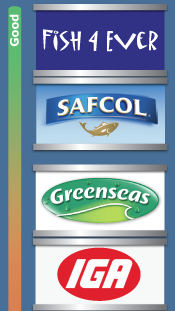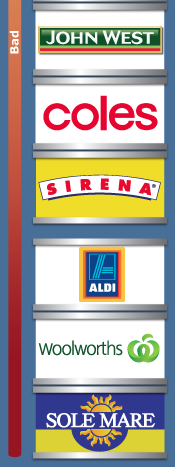*This post has been updated.
A while back I did a post on which tinned tuna to buy… and I’ve been updating the guide ever since, as soon as Greenpeace sends me their new data. Buying the right tuna is a dead easy way to do the right thing. A simple choice at the supermarket: sustainable or otherwise.
December 2013:
A note from Greenpeace: Our new canned tuna ranking is online. And the good news is that every single brand in it is committed to FAD-free and pole and line fishing. Aldi’s commitment is for FAD-free and pole and line by the end of 2016, they’ve jumped ahead of their supermarket rivals and are already only ordering pole and line.
These brands at the top of the list are the ones you should be buying:
Since the first post, manufacturers have made some terrific changes, based on consumer demand and the work Greenpeace has done to promote these better choices. Almost all Australian companies are supporting the no-fishing zones in the Pacific, known as the Pacific Commons, to protect tuna stocks into the future and many of the big brands are phasing out bad practices.
The five things you need to know:
* Always opt for “pole and line”. This will steer you to the most sustainable choice.
* Safcol is your surest bet for now: they’re now 100% sustainable!
* Some brands are gradually phasing out the destructive fish aggregating devices (FADs) and are starting to provide “pole and line” options in their range: Support these new options with your dollar!
* Greenseas and Sirena will be offering “pole and line” options soon. IGA homebrand already does!
Update: Sirena tuna is now 100% “pole and line” caught. Hooray!
* All Australian brands are using sustainable tuna breeds now
* John West is dragging the chain, refusing to ban FADs. Which is sad as they supply the largest amount of tuna in the country and the UK and US versions have already gone 100% sustainable.
Update: John West is committed to discontinuing sources of FAD-caught fish by 2015.
These brands are the ones you should be avoiding:
Why pole and line?
- less sharks, turtles, whales and dolphins will be killed. Most canned tuna is caught with FADs and nets. These scoop up and kill anything in their reach. Pole and line fishing is much more selective. Other creatures are rarely caught, and if they are, they can usually be returned to water.
- the rate of fishing is more sustainable. These days fishing vessels catch fish faster than nature can replenish. Buying pole and line tuna keeps access to fish with the coastal fisherman, without adding more giant fishing vessels into the mix.
- tuna species that are under pressure will be given a break. Skipjack tuna is in the healthiest state, while bigeye and yellowfin are in decline. Pole and line fishing means we can eliminate bigeye and yellowfin catch, and focus rather on targeting skipjack.
- more local fisherman can be employed. Big fishing vessels usually fish Pacific Island tuna having come from nations far away. Pole and line fishing requires more local fishermen to be employed. This provides vital employment in island states, and without harmful impact on the sea.
- developing coastal nations will feel the benefit. The global tuna industry is worth over $5 billion a year, but most profits don’t end up in the countries the tuna was fished from. Pole and line fishing means more opportunity for local ownership.
- it won’t hurt your hip pocket. These days, thanks to consumer pressure, many of the big brands offer a pole and line product that is affordable. And the more people swap for pole and line tuna, the more that price will continue to fall.
Interesting to know: all the pole and line products (except Woolworths’) are skipjack tuna, which is significantly lower in mercury than yellowfin (which Sirena is full of).
Why not also check out this helpful app.
Hope you’ve found this useful…



